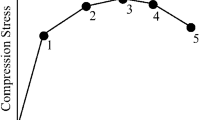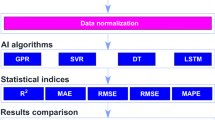Abstract
Particle-based discrete element modeling is commonly used in the numerical analysis of geomaterials. However, for the construction of such models, micromechanical parameters should be calibrated such that a set of microproperties must be chosen carefully to reproduce the macroscopic behavior of the geomaterial. This paper explores the use of the adaptive network-based fuzzy inference system (ANFIS), support vector machine (SVM), Gaussian process regression (GPR), and multivariate adaptive regression splines (MARS) methods for predicting the uniaxial compressive strength (UCS) of the Voronoi-based universal distinct element code (UDEC) model based on microshear strength properties of contacts. The data for training and testing the ANFIS, SVM, GPR, and MARS models were obtained from 121 numerically simulated Voronoi-based UCS models. Several statistical functions (\({R}^{2}\), RMSE, MAE, and VAF) were utilized to check the performances of the predictive models. The high performance indices of the models highlight the capability of the ANFIS, SVM, GPR, and MARS (with interaction terms) models in making a rapid assessment of the calibration process.







Similar content being viewed by others
References
Alzo'ubi AM (2009) The effect of tensile strength on the stability of rock slopes. Ph.D. Thesis. University of Alberta, Edmonton
Bai Q, Tu S (2020) Numerical observations of the failure of a laminated and jointed roof and the effective of different support schemes: a case study. Environ Earth Sci 79:1–18. https://doi.org/10.1007/s12665-020-08935-2
Christianson M, Board M, Rigby D (2006) UDEC simulation of triaxial testing of lithophysal tuff. In: Golden Rocks 2006, The 41st US symposium on rock mechanics (USRMS). American Rock Mechanics Association
Damjanac B, Fairhurst C (2010) Evidence for a long-term strength threshold in crystalline rock. Rock Mech Rock Eng 43(5):513–531
Fathipour-Azar H, Saksala T, Jalali SME (2017) Artificial neural networks models for rate of penetration prediction in rock drilling. Rakenteiden Mekaniikka 50(3):252–255. https://doi.org/10.23998/rm.64969
Fathipour-Azar H, Wang J, Jalali SME, Torabi SR (2020) Numerical modeling of geomaterial fracture using a cohesive crack model in grain-based DEM. Comput Part Mech 7:645–654. https://doi.org/10.1007/s40571-019-00295-4
Friedman JH (1991) Multivariate adaptive regression splines. Ann Stat 19(1):1–67. https://doi.org/10.1214/aos/1176347963
Gao FQ, Stead DOUG (2014) The application of a modified Voronoi logic to brittle fracture modelling at the laboratory and field scale. Int J Rock Mech Min Sci 68:1–14
Goh ATC, Zhang W, Zhang Y, Xiao Y, Xiang Y (2018) Determination of earth pressure balance tunnel-related maximum surface settlement: a multivariate adaptive regression splines approach. Bull Eng Geol Environ 77(2):489–500. https://doi.org/10.1007/s10064-016-0937-8
Goh AT, Zhang Y, Zhang R, Zhang W, Xiao Y (2017) Evaluating stability of underground entry-type excavations using multivariate adaptive regression splines and logistic regression. Tunn Undergr Space Technol 70:148–154. https://doi.org/10.1016/j.tust.2017.07.013
Guo J, Xu G, Jing H, Kuang T (2013) Fast determination of meso-level mechanical parameters of PFC models. Int J Min Sci Technol 23(1):157–162
Itasca (2014) Itasca Consulting Group Inc., The Universal Distinct Element Code (UDEC), Ver. 6.0., Minneapolis, USA
Jang JS (1993) ANFIS: adaptive-network-based fuzzy inference system. IEEE Trans Syst Man Cybern 23(3):665–685
Kazerani T (2013) Effect of micromechanical parameters of microstructure on compressive and tensile failure process of rock. Int J Rock Mech Min Sci 64:44–55
Kazerani T, Zhao J (2010) Micromechanical parameters in bonded particle method for modelling of brittle material failure. Int J Numer Anal Meth Geomech 34(18):1877–1895
Lan H, Martin CD, Hu B (2010) Effect of heterogeneity of brittle rock on micromechanical extensile behavior during compression loading. J Geophys Res: Solid Earth 115(B1):B01202
Li B, Gong W, Tang H, Zou Z, Bowa VM, Juang CH (2021) Probabilistic analysis of a discrete element modelling of the runout behavior of the Jiweishan landslide. Int J Numer Anal Meth Geomech. https://doi.org/10.1002/nag.3199
Li X, Ju M, Yao Q, Zhou J, Chong Z (2016) Numerical investigation of the effect of the location of critical rock block fracture on crack evolution in a gob-side filling wall. Rock Mech Rock Eng 49(3):1041–1058. https://doi.org/10.1007/s00603-015-0783-1
Lorig LJ, Watson AD, Martin CD, Moore DP (2009) Rockslide run-out prediction from distinct element analysis. Geomech Geoeng: Int J 4(1):17–25
Nicksiar M, Martin CD (2014) Factors affecting crack initiation in low porosity crystalline rocks. Rock Mech Rock Eng 47(4):1165–1181. https://doi.org/10.1007/s00603-013-0451-2
Rasmussen CE, Williams CKI (2006) Gaussian processes for machine learning. MIT Press, Cambridge, MA
Shin SW, Martin CD, Park ES, Christiansson R (2007) Methodology for estimation of excavation damaged zone around tunnels in hard rock. In: 1st Canada–US rock mechanics symposium
Sinha S, Walton G (2020) A study on Bonded Block Model (BBM) complexity for simulation of laboratory-scale stress-strain behavior in granitic rocks. Comput Geotech 118:103363. https://doi.org/10.1016/j.compgeo.2019.103363
Tawadrous AS, DeGagné D, Pierce M, Mas Ivars D (2009) Prediction of uniaxial compression PFC3D model micro-properties using artificial neural networks. Int J Numer Anal Meth Geomech 33(18):1953–1962. https://doi.org/10.1002/nag.809
Vapnik V (1995) The nature of statistical learning. Springer, New York
Vapnik V, Vapnik V (1998) Statistical learning theory. Springer, New York
Xu C, Liu X, Wang E, Wang S (2021) Calibration of the microparameters of rock specimens by using various machine learning algorithms. Int J Geomech 21(5):04021060. https://doi.org/10.1061/(ASCE)GM.1943-5622.0001977
Zhang WG, Goh ATC (2013) Multivariate adaptive regression splines for analysis of geotechnical engineering systems. Comput Geotech 48:82–95. https://doi.org/10.1016/j.compgeo.2012.09.016
Zhang W, Wu C, Li Y, Wang L, Samui P (2021) Assessment of pile drivability using random forest regression and multivariate adaptive regression splines. Georisk: Assess Manag Risk Eng Syst Geohazards 15(1):27–40. https://doi.org/10.1080/17499518.2019.1674340
Zhang W, Zhang R, Wu C, Goh ATC, Lacasse S, Liu Z, Liu H (2020) State-of-the-art review of soft computing applications in underground excavations. Geosci Front 11(4):1095–1106. https://doi.org/10.1016/j.gsf.2019.12.003
Author information
Authors and Affiliations
Corresponding author
Additional information
Publisher's Note
Springer Nature remains neutral with regard to jurisdictional claims in published maps and institutional affiliations.
Rights and permissions
About this article
Cite this article
Fathipour-Azar, H. Machine learning-assisted distinct element model calibration: ANFIS, SVM, GPR, and MARS approaches. Acta Geotech. 17, 1207–1217 (2022). https://doi.org/10.1007/s11440-021-01303-9
Received:
Accepted:
Published:
Issue Date:
DOI: https://doi.org/10.1007/s11440-021-01303-9




